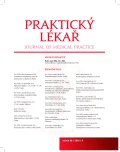Surrogacy in the Czech Republic: current status and the responsibility of the general practicioner
Authors:
H. Konečná 1
; K. Nováková 2; L. Prudil 3; I. Honzová 3; L. Prudilová 3
Published in:
Prakt. Lék. 2018; 98(6): 270-274
Category:
Law and Medicine
Overview
Introduction:
Surrogate motherhood (NM in the text) is the procedure whereby a woman undergoes assisted reproduction, pregnancy and childbirth in order to transfer parental rights and obligations, after giving birth, to someone previously appointed. According to the recommendation of the Assisted Reproduction Section of the ČGPS ČLS, a NM adept should have a written recommendation of a GP. The article describes the situation in the Czech Republic, defines tasks of the GP.
Methods:
The presented results are based on 4 data sources: 1. communication with Czech maternity hospitals and neonatology about their experience with NM; 2. communication with Czech centres of assisted reproduction on their experiences with NM; 3. analysis of websites of Czech centres of assisted reproduction; 4. analysis of forums and online portals.
Results:
Interest in NM is growing steeply in the Czech Republic. Czech maternity hospitals come together with the births of surrogate mothers, some of them have developed their own legal procedures. Applicants are looking for a substitute mother mostly over the Internet, usually a single or divorced woman from a lower socio-economic class. After delivery, the applicant’s partner is usually registered as a father (regardless of the child’s genetic origin), his partner applies for adoption.
Conclusion:
With the social acceptance of the procedure, the number of cycles continues to grow. The GP gets into the role of an expert, co-responsible of the process. S/he can not only judge the health status of her/his registered patient, but also take into account the psychosocial, ethical and legal context of the situation.
KEYWORDS:
surrogate motherhood – responsibility – general practitione
Sources
1. Císařová D, Sovová O. Náhradní mateřství v právní praxi. Čas. zdr. práva bioet. 2015; 5(2): 13–24.
2. Fertility Europe and European Society of Human Reproduction and Embryology. A policy audit on fertility. Analysis of 9 EU countries [on line]. Dostupný z: www.fertilityeurope.eu/wp-content/uploads/2018/03/EPAF_FINAL.pdf [cit. 2018-09-29].
3. FIGO Committee for the Study of Ethical Aspects of Human Reproduction and Women’s Health. Ethical Issues in Obstetrics and Gynecology. London: FIGO House 2009.
4. Jadva V, Blake L, Casey P, Golombok S. Surrogacy families 10 years on: relationship with the surrogate, decisions over disclosure and children‘s understanding of their surrogacy origins. Hum Reprod 2012; 27(10): 3008–3014.
5. Konečná H. Rodičem kdykoliv a jakkoliv? Průvodce asistovanou reprodukcí a náhradní rodinnou péčí. Praha: Mladá fronta 2017.
6. Konečná H, Klůfa J, Doskočil O, Bubleová V. Anonymní dárcovství gamet a anonymní porody: společné etickopsychosociální a právní aspekty. Prakt. Lék. 2012; 92(10–12): 546–550.
7. Nováková K, Konečná H, Sudová M. Náhradní mateřství v České republice: způsoby hledání náhradní matky. Čas. zdr. práva bioet. 2018; 8(2): 32–42.
8. Paleček J, a kol. Model osvojování. Praha: Středisko náhradní rodinné péče 2017.
9. Pektorová M, Ventruba P. Surogace, ano či ne? Kazuistika. Čes. Gynek. 2015; 80(4): 299–301.
10. Pilka L, Rumpík D, Pilka R, a kol. Surogátní mateřství – literární názory a praxe. Čes. Gynek. 2009; 74(2): 144–147.
11. Právní zpravodaj Vydavatelství C. H. Beck. Spolupráce ministryní spravedlnosti a zdravotnictví v oblasti náhradního mateřství [online]. Dostupné z: https://www.beck-online.cz/spoluprace-ministryni-spravedlnosti-a-zdravotnictvi-v-oblasti-nahradniho-materstvi/ [cit. 2018-09-29].
12. Shenfield F, Pennings G, Cohen J, et al. ESHRE task force on ethics and law 10: surrogacy. Hum Reprod 2005; 20(10): 2705–2707.
13. van den Akker OBA. Surrogate motherhood: A critical perspective. Exp Rev Obstet Gynecol 2010; 5(1): 5–7.
Labels
General practitioner for children and adolescents General practitioner for adultsArticle was published in
General Practitioner

2018 Issue 6
- Metamizole at a Glance and in Practice – Effective Non-Opioid Analgesic for All Ages
- Memantine in Dementia Therapy – Current Findings and Possible Future Applications
- Advances in the Treatment of Myasthenia Gravis on the Horizon
- Possibilities of Using Metamizole in the Treatment of Acute Primary Headaches
- Hope Awakens with Early Diagnosis of Parkinson's Disease Based on Skin Odor
Most read in this issue
- Dark lesions in the oral cavity – differential diagnosis
- Surrogacy in the Czech Republic: current status and the responsibility of the general practicioner
- Use of telerehabilitation as a complement to regular rehabilitation care
- Analysis of the most common food-and water-borne diseases in the Czech Republic, 2007–2017
